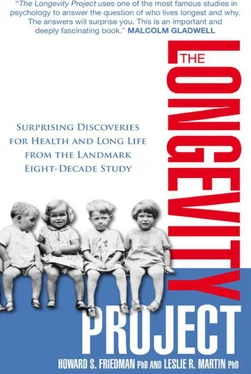Douglas Kelley swallowed cyanide more than a decade after seeing the horror of the Nazis up close. His suicide decision appeared sudden and unprovoked. After all, in the intervening years, he’d had a family and built a successful career as a professor, doctor, and researcher. But, from intensive study of the Terman participants, we know that those who committed suicide did not suddenly and erratically fall off the path. Negative thoughts became more and more consuming and started to influence feelings and behaviors.
When the actress Marilyn Monroe was found dead of an overdose of barbiturates at age thirty-six, there was much uncertainty about whether this was an accident, a suicide, or even a murder. Dr. Shneidman was called in to work with the coroner and perform what he called a psychological autopsy. He saw that Marilyn Monroe had come from an unstable family, had faced a difficult childhood, had been impulsive and unreliable, had had many romantic relationships and three marriages, and, as the stress of her career built, had turned to alcohol and prescription drugs. She fit the suicidal pattern, and the coroner ruled her death a probable suicide.
Our studies of catastrophizing, coupled with the explorations of Terman subject suicides by Drs. Tomlinson-Keasey, Shneidman, and others, present a multisided picture of those predisposed to a violent death before age sixty. Such individuals not only faced overly dramatic thoughts but they were inclined to dramatic, precipitous actions. They were not only worried about failures but they were often missing something from childhood—usually a parent’s love. They often had headed down a path of alcohol, divorce, or loneliness, but sometimes, as with Douglas Kelley, they had stared into the abyss of a world they could not fathom.
If someone is already far down a self-destructive pathway, the intensive measures needed for detox and sobering up are well-known; they often involve a period of very close monitoring by professionals. But what about someone who has tendencies that could lead in that direction, but who has many strengths as well?
The good news is that catastrophic and related negative thought processes can be changed. The first step is recognizing thoughts for what they are—merely thoughts. This doesn’t mean that they are unimportant or hold no power; we have seen dramatic illustrations of their potency in the lives of some of the Terman subjects, for instance. But the power of thoughts can be harnessed, and this is the basic premise behind cognitive therapy.
Cognitive therapy focuses on changing harmful thoughts using techniques such as “thought stopping.” When you start to think catastrophic thoughts, you literally say to yourself, “Stop!” This is immediately followed by “thought replacement,” which is replacing the negative thoughts with more positive ones. It’s actually very difficult to simply not think about something. Try not thinking about a purple penguin. You likely were not thinking of a purple penguin a minute ago, but now that we’ve brought it to your attention, it’s hard to get it out of your head. The best way to banish penguin thoughts is to focus elsewhere. Thought replacement requires the individual who has just stopped a negative thought to replace it with something else—something positive or distracting.
Rationally examining catastrophizing thought patterns and beliefs also proves useful. Most people probably recognize, at least in part, that things aren’t really as bad as all that, but this nugget of truth gets lost amid all the chaos of perceived calamity. Taking time to thoughtfully evaluate the situation—“What is the worst-case scenario?” or “How likely is it that all of my friends really hate me?”—and to replace inaccurate, catastrophe-oriented thoughts and beliefs with more rational and realistic ones is a worthwhile exercise. Often, writing them down can help. Many recovering catastrophizers benefit from keeping a daily diary, in which they recall the good things that happened today, dismiss the catastrophizing, and write logical plans for tomorrow. But anyone with a troubling, chronic mental health problem should not try to self-diagnose or self-treat. Professional consultations can point one toward the treatments that are most likely to be successful in any particular case.
Again, this may sound simple, but making changes to habitual patterns of thought takes patience, persistence, and determination. Many find that they are too lost in the catastrophizing to do it alone and choose to seek the help of a therapist. Whatever the method, the good news is that catastrophizers do have it in their power to become more realistic, and to learn to laugh it off should an acorn drop on their heads.
CHAPTER 6
Childhood and School Days
Head Start, Early Finish
Philip, a healthy infant, weighed seven pounds at birth. He was not breast-fed. His toddler years were uneventful. A precocious learner, he began first grade at an unusually young age. How did such early characteristics and experiences affect later health and longevity?
The effects of early life events on later health are puzzling. For example, nutritional problems at a very young age might predispose a child to later heart disease and other adult illnesses, and impaired childrearing can affect later reactions to stressful challenges; but most children seem unaffected. Severe deficiencies are obviously a problem, but what about the large number of common variations—are these findings about early risks mostly hype, or are they serious factors to worry about?
The Terman children’s weight at birth ranged from under six pounds to ten pounds, with the average being about eight pounds. Some were not in good health during their first year while others were quite hearty. Later in childhood, some were judged by Terman and his staff or by physicians to be “below average” in health while others were “very superior.” Some had undergone surgeries or had serious accidents during early childhood while others had never been hospitalized. Of course all were doing well enough to be recruited by Terman into his study, and we cannot reach any conclusions here about very ill or traumatized children.
Startlingly, these and many related early health indicators were not associated with long life. Generally speaking, a simple early health advantage or disadvantage was not that important to later health trajectories. This does not mean that some such small relations or associations could not be found in a very large study of hundreds of thousands of children. And it certainly is true that significant malnutrition, significant prematurity, or significant exposure to toxins (including prenatal alcohol exposure) can translate into very serious long-term health threats.
However, unless there is brain damage, our research has led us to be skeptical about claims that a single indicator of early health would usually be of lasting significance across the decades for most middle-class people. We found that many aspects of early life do indeed matter, but typically only as part of general patterns that build and become more pronounced throughout life.
The typical Terman child was breast-fed for about eight months. But many were not breast-fed at all, and a few were breast-fed until they were three years old.
Perhaps because a newborn is so frail and helpless or perhaps because it’s a practice that’s entangled with culture and gender wars, breast-feeding often provokes heated debate. Many women worry and struggle as to whether and how long they should breast-feed their babies. In the United States, breast-feeding has taken a place in the pantheon of health behaviors about which to agonize and fret.
Читать дальше











